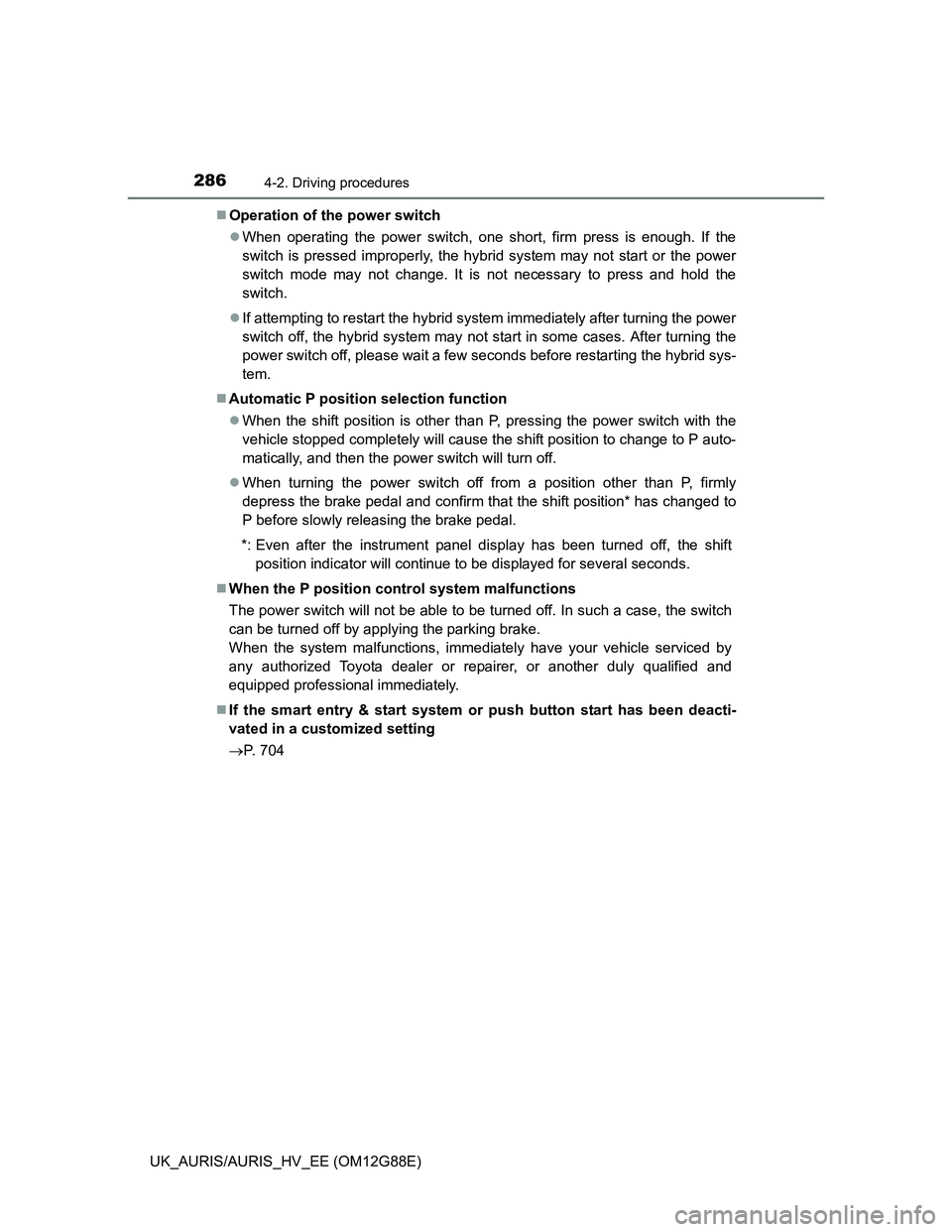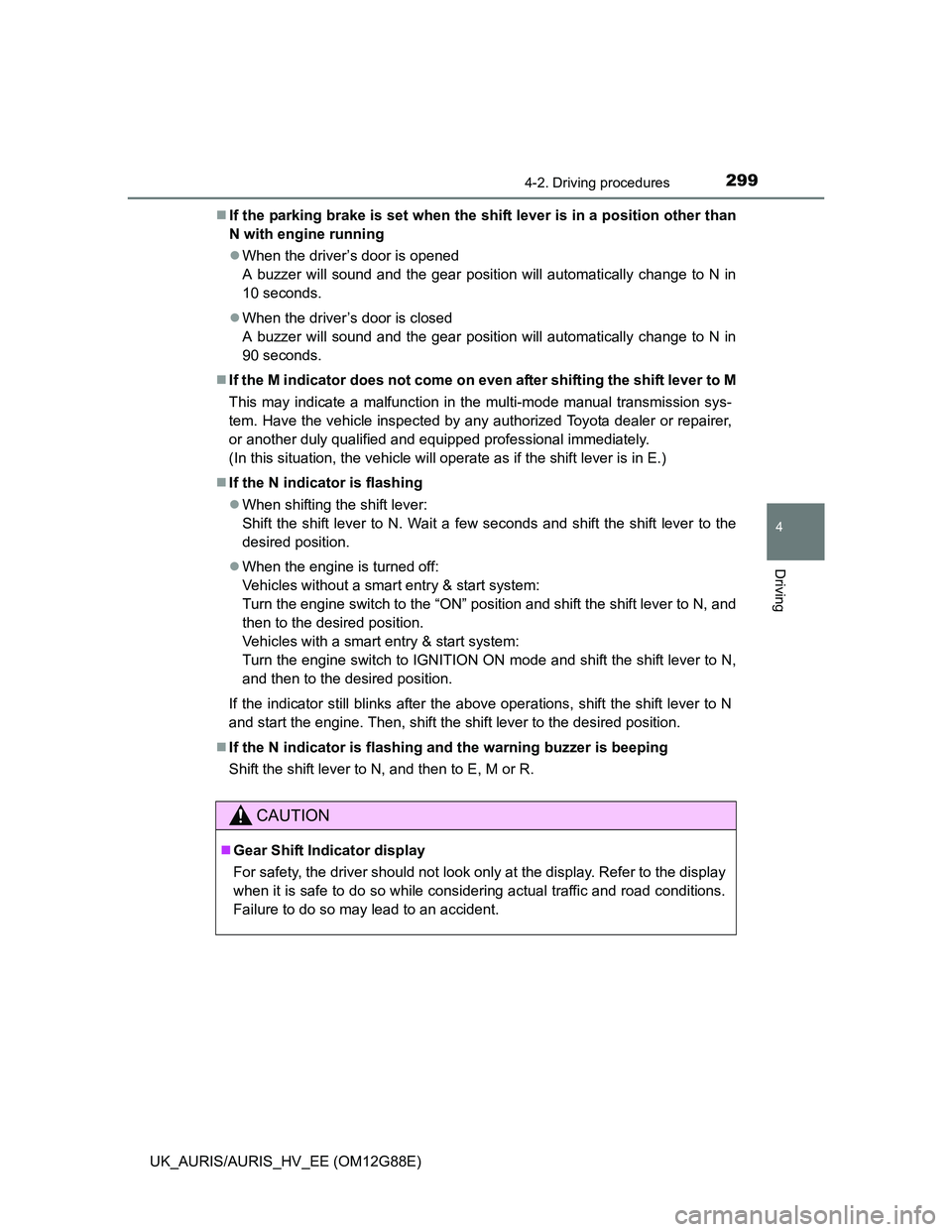Page 277 of 788
2774-2. Driving procedures
UK_AURIS/AURIS_HV_EE (OM12G88E)
4
Driving
If the engine is stopped with the shift lever in a position other than P,
the engine switch will not be turned off but instead be turned to
ACCESSORY mode. Perform the following procedure to turn the
switch off:
Check that the parking brake is set.
Shift the shift lever to P.
Vehicles without a multi-information display:
Check that the smart entry & start system indicator light (green)
flashes slowly and then press the engine switch once.
Check that the smart entry & start system indicator light (green) is
off.
Vehicles with a multi-information display:
Check that “POWER ON” and “TURN POWER OFF” are displayed
alternately on the multi-information display and then press the
engine switch once.
Check that “POWER ON” and “TURN POWER OFF” on the multi-
information display are off.
When stopping the engine with the shift lever in a position other
than P (vehicles with a Multidrive)
1
2
3
4
3
4
Page 282 of 788
2824-2. Driving procedures
UK_AURIS/AURIS_HV_EE (OM12G88E)
Check that the parking brake is set.
Firmly depress the brake pedal.
will be displayed on the multi-information display.
If it is not displayed, the hybrid system cannot be started.
When shift position N is selected, the hybrid system cannot start. Select
the P position when starting the hybrid system. (P. 303)
Press the power switch.
After a few seconds, the “READY”
indicator comes on with a beep
sound.
The vehicle can move when the
“READY” indicator is on, even if
the engine is stopped.
Continue depressing the brake
pedal until the hybrid system is
completely started.
The hybrid system can be started
from any power switch mode.
Power (ignition) switch (hybrid model)
Performing the following operations when carrying the elec-
tronic key on your person starts the hybrid system or changes
power switch modes.
Starting the hybrid system
1
2
3
Page 283 of 788
2834-2. Driving procedures
UK_AURIS/AURIS_HV_EE (OM12G88E)
4
Driving
Stop the vehicle by depressing the brake pedal.
Set the parking brake. (P. 312)
Press the “P” position switch.
(P. 303)
Check that the shift position indica-
tor on the instrument cluster shows
P. (P. 116)
Press the power switch.
Release the brake pedal and check that “POWER ON” on the multi-
information display is off.
Stopping the hybrid system
1
2
3
4
5
Page 286 of 788

2864-2. Driving procedures
UK_AURIS/AURIS_HV_EE (OM12G88E)Operation of the power switch
When operating the power switch, one short, firm press is enough. If the
switch is pressed improperly, the hybrid system may not start or the power
switch mode may not change. It is not necessary to press and hold the
switch.
If attempting to restart the hybrid system immediately after turning the power
switch off, the hybrid system may not start in some cases. After turning the
power switch off, please wait a few seconds before restarting the hybrid sys-
tem.
Automatic P position selection function
When the shift position is other than P, pressing the power switch with the
vehicle stopped completely will cause the shift position to change to P auto-
matically, and then the power switch will turn off.
When turning the power switch off from a position other than P, firmly
depress the brake pedal and confirm that the shift position* has changed to
P before slowly releasing the brake pedal.
*: Even after the instrument panel display has been turned off, the shift
position indicator will continue to be displayed for several seconds.
When the P position control system malfunctions
The power switch will not be able to be turned off. In such a case, the switch
can be turned off by applying the parking brake.
When the system malfunctions, immediately have your vehicle serviced by
any authorized Toyota dealer or repairer, or another duly qualified and
equipped professional immediately.
If the smart entry & start system or push button start has been deacti-
vated in a customized setting
P. 704
Page 299 of 788

2994-2. Driving procedures
UK_AURIS/AURIS_HV_EE (OM12G88E)
4
Driving
If the parking brake is set when the shift lever is in a position other than
N with engine running
When the driver’s door is opened
A buzzer will sound and the gear position will automatically change to N in
10 seconds.
When the driver’s door is closed
A buzzer will sound and the gear position will automatically change to N in
90 seconds.
If the M indicator does not come on even after shifting the shift lever to M
This may indicate a malfunction in the multi-mode manual transmission sys-
tem. Have the vehicle inspected by any authorized Toyota dealer or repairer,
or another duly qualified and equipped professional immediately.
(In this situation, the vehicle will operate as if the shift lever is in E.)
If the N indicator is flashing
When shifting the shift lever:
Shift the shift lever to N. Wait a few seconds and shift the shift lever to the
desired position.
When the engine is turned off:
Vehicles without a smart entry & start system:
Turn the engine switch to the “ON” position and shift the shift lever to N, and
then to the desired position.
Vehicles with a smart entry & start system:
Turn the engine switch to IGNITION ON mode and shift the shift lever to N,
and then to the desired position.
If the indicator still blinks after the above operations, shift the shift lever to N
and start the engine. Then, shift the shift lever to the desired position.
If the N indicator is flashing and the warning buzzer is beeping
Shift the shift lever to N, and then to E, M or R.
CAUTION
Gear Shift Indicator display
For safety, the driver should not look only at the display. Refer to the display
when it is safe to do so while considering actual traffic and road conditions.
Failure to do so may lead to an accident.
Page 312 of 788
3124-2. Driving procedures
UK_AURIS/AURIS_HV_EE (OM12G88E)
To set the parking brake, fully
pull the parking brake lever
while depressing the brake
pedal.
To release the parking brake,
slightly raise the lever and
lower it completely while press-
ing the button.
Parking brake engaged warning buzzer
A buzzer will sound if the vehicle is driven at a speed of approximately 5 km/h
(3 mph) or more with the parking brake engaged. (P. 613)
Usage in winter time
P. 386
Parking brake
Operating instructions
1
2
NOTICE
Before driving
Fully release the parking brake.
Driving the vehicle with the parking brake set will lead to brake components
overheating, which may affect braking performance and increase brake
wear.
Page 319 of 788

3194-3. Operating the lights and wipers
UK_AURIS/AURIS_HV_EE (OM12G88E)
4
Driving
Daytime running light system
Except hybrid model
To make your vehicle more visible to other drivers, the front position lights
turn on automatically whenever the engine is started and the parking brake is
released. Daytime running lights are not designed for use at night.
Hybrid model
To make your vehicle more visible to other drivers, the front position lights
turn on automatically whenever the hybrid system is started and the parking
brake is released. Daytime running lights are not designed for use at night.
Headlight control sensor (if equipped)
Automatic light off system
Except hybrid model (vehicles without a smart entry & start system)
When the light switch is in or : The headlights and front fog lights
(if equipped) turn off automatically if the engine switch is turned off.
When the light switch is in : All lights turn off automatically if the engine
switch is turned off.
To turn the lights on again, turn the engine switch to the “ON” position, or turn
the light switch off once and then back to or .
Except hybrid model (vehicles with a smart entry & start system)
When the light switch is in or : The headlights and front fog lights
(if equipped) turn off automatically if the engine switch is turned off.
When the light switch is in : All lights turn off automatically if the engine
switch is turned off.
To turn the lights on again, turn the engine switch to IGNITION ON mode, or
turn the light switch off once and then back to or . The sensor may not function properly if an
object is placed on the sensor, or anything
that blocks the sensor is affixed to the
windshield.
Doing so interferes with the sensor
detecting the level of ambient light and
may cause the automatic headlight sys-
tem to malfunction.
Page 350 of 788

3504-5. Using the driving support systems
UK_AURIS/AURIS_HV_EE (OM12G88E)
Sensor detection information
Certain vehicle conditions and the surrounding environment may affect the
ability of the sensor to correctly detect obstacles. Particular instances where
this may occur are listed below.
• There is dirt, snow or ice on the sensor.
• A sensor is frozen.
• A sensor is covered in any way.
• The vehicle is leaning considerably to one side.
• On an extremely bumpy road, on an incline, on gravel, or on grass.
• The vicinity of the vehicle is noisy due to vehicle horns, motorcycle
engines, air brakes of large vehicles, or other loud noises producing ultra-
sonic waves.
• There is another vehicle equipped with parking assist sensors in the
vicinity.
• A sensor is coated with a sheet of spray or heavy rain.
• The vehicle is equipped with a fender pole or wireless antenna.
• Towing eyelet is installed.
• A bumper or sensor receives a strong impact.
• The vehicle is approaching a tall or curved curb.
• In harsh sunlight or intense cold weather.
• A non-genuine Toyota suspension (lowered suspension etc.) is installed.
In addition to the examples above, there are instances in which, because of
their shapes, signs and other objects may be judged by the sensor to be
closer than they are.
The shape of the obstacle may prevent the sensor from detecting it. Pay
particular attention to the following obstacles:
• Wires, fences, ropes, etc.
• Cotton, snow and other materials that absorb sound waves
• Sharply-angled objects
• Low obstacles
• Tall obstacles with upper sections projecting outwards in the direction of
your vehicle
If a message is displayed
P. 631